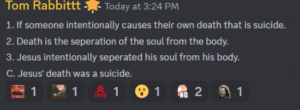QUESTION: Creationists keep missing one very important detail; what happened between Noah and Jesus? That’s only 2,500 years. God killed all life on land, even that which creepeth on the earth. If I take the Bible literally, then he killed worms, beetles, microbes, bacteria, and everything else that makes the soil fertile. When Noah landed, he only had two worms, two beetles, two microbes, etc. He also only had seven people with him. Given these severe restrictions, Noah had to found the kingdom of Egypt, the dynasties of China, the Indian culture of North and South America, in perhaps only a hundred years. Modern Archeology can provide dates not only through carbon dating but, in the case of China, from one the history of one uninterrupted culture. Noah had one square inch of fertile soil on the side of Mount Ararat, thousands of hungry animals, and seeds waiting to be planted. He also had to found all of our modern human cultures. Make a timeline specific to location and population, in decade increments. It’s only 2,400 years–that’s a heck of a lot easier than 4 billion.
RESPONSE: Creationists haven’t missed that little detail, but I think you missed some of what the Bible says. There were two qualifications for the animals on board the Ark: they not only had to be those which moved about on the earth, but also those that had the breath of life, or “nephesh.” The word “nephesh” refers to those animals with soul: or if you like, “responsive personality.” Thus, you would have all mammals that lived on land, reptiles, and birds. Amphibians did not need the Ark, and insects, worms, bacteria, etc., do not have a nervous system which is complex enough to mark the animal or organism as having a uniqueness and the trainability which “nephesh” implies. Thus, these organisms were preserved in various ways outside the Ark through the flood.
Regarding the food situation, if you read Genesis, you will notice that no one disembarked until the dove brought back an olive shoot. Olives do not grow as quickly as grass, and so there is the indication that the vegetation was quite adequate for survival immediately after release from the Ark.
As far as the cultures are concerned, you will find a very accurate and widely-referred-to Table of Nations in Genesis 10. It is used by archaeologists, historians, and linguists to help trace the roots of various ancient cultures and has proven to be quite accurate. As far as repopulation of the earth is concerned, not much time was needed for the early civilizations. In Genesis 11 you will read of the long ages (although only half of what they were pre-flood), which then went down again after the event of Peleg’s time and gradually, after that, to what we know today as the upper limit on human ages–about 120 years. In the early generations, we read of families being rather large, and when the average family has about six children or more, the population can grow quite rapidly.






